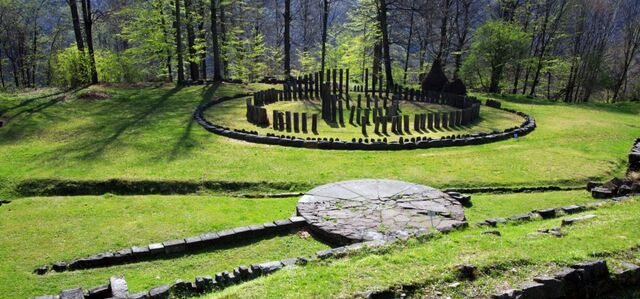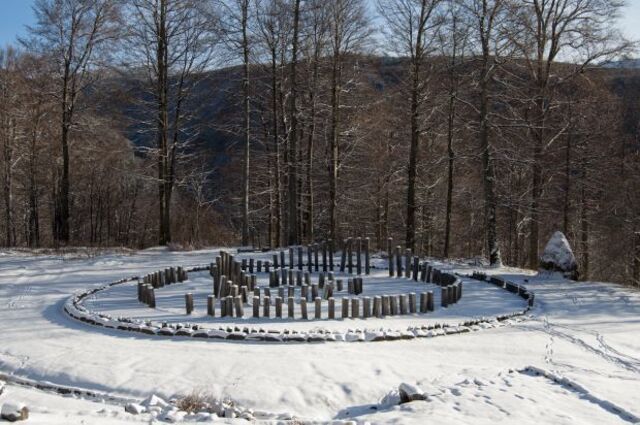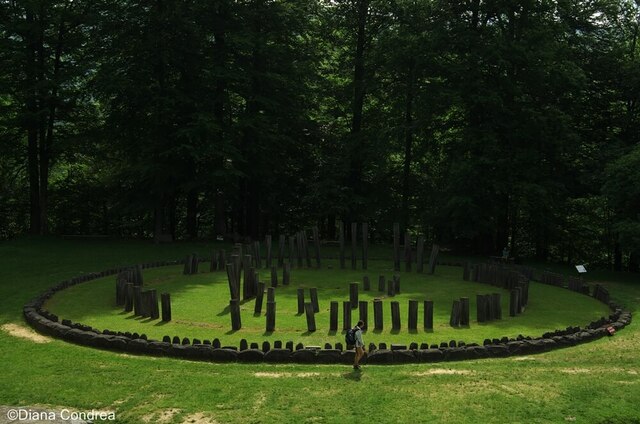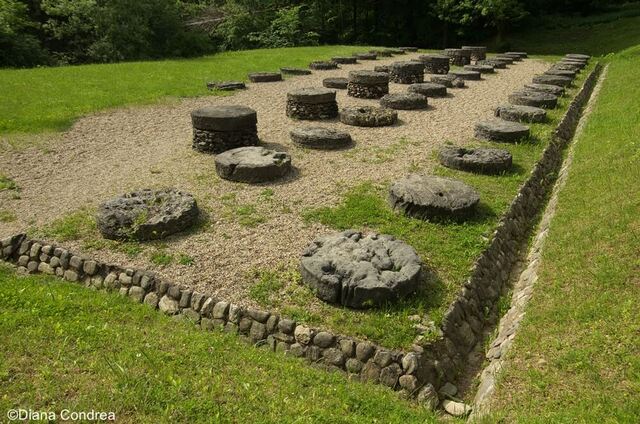Hidden deep in the forests of Romania’s Carpathian Mountains, Sarmizegetusa Regia stands as a testament to the power and mystery of the ancient Dacian civilization. Once the thriving capital of Dacia, this UNESCO World Heritage site offers a fascinating glimpse into a forgotten world. From its impressive fortifications to its sacred temples, Sarmizegetusa Regia invites visitors to uncover its secrets and experience the legacy of a people long before Roman conquest. A journey to this ancient stronghold is more than just a visit; it’s a step back in time.
The History of Sarmizegetusa Regia
Origins of the Fortress and Its Strategic Location
Sarmizegetusa Regia, the capital of the ancient Dacian Kingdom, was strategically located in the Orăștie Mountains, surrounded by natural barriers that made it an ideal site for defense. Founded in the second half of the 1st century BC, this fortress became the core of the Dacian defensive system. The Dacians, a fierce and sophisticated people, chose this location not only for its defensive advantages but also for its proximity to rich natural resources, particularly iron, which played a crucial role in the kingdom’s economy.

Development under King Decebalus
Sarmizegetusa Regia reached its peak during the reign of King Decebalus, the last ruler of an independent Dacia. Under his leadership, the fortress expanded significantly. Decebalus transformed Sarmizegetusa into a formidable military stronghold, while also establishing a thriving settlement that included religious, administrative, and residential buildings. The fortress was not just a place of defense but also a cultural and spiritual center, where the Dacians practiced their religious rites and rituals.
However, the grandeur of Sarmizegetusa Regia would soon come to an end. In 106 AD, following two major wars, the Dacians were defeated by the Roman Empire under Emperor Trajan, marking the beginning of Roman dominance in the region.
Roman Conquest and Transition to Ulpia Traiana
After the Roman victory, Sarmizegetusa Regia was abandoned in favor of a new Roman capital, Ulpia Traiana Sarmizegetusa, which was established by Trajan. The Romans sought to assert their control over the region, building their own fortress and town on the ruins of the old Dacian capital. Though Sarmizegetusa Regia ceased to be the political center of Dacia, its legacy lived on in the Romanized city that followed.
Video
Watch the video podcast HISTORY: #5 Sarmizegetusa – Legend and Truth, where the fascinating history of Sarmizegetusa is revealed. Discover the truth behind the legend!
Exploring the Dacian Fortress
One of the most striking features of Sarmizegetusa Regia is its impressive fortifications. The fortress was surrounded by a three-meter-thick wall, designed to protect it from invaders. The wall, although now in ruins, still offers a glimpse into the engineering prowess of the Dacians. The fortifications were complemented by watchtowers and gates, which provided both defense and a strategic advantage in terms of controlling the surrounding areas.
Inside the fortress, there were distinct military and civilian areas. The military barracks and training grounds were located near the perimeter of the site, while the residential area was situated closer to the heart of the fortress.

The Sacred Area of Sarmizegetusa Regia is another fascinating aspect of the site. This religious complex consisted of several temples and altars, where the Dacians performed their rituals, including sacrifices to their gods. The most notable feature of the Sacred Area is the Large Sanctuary, a circular structure that is often compared to Stonehenge in England due to its similar design. The sanctuary is believed to have had an astronomical function, with certain alignments allowing the Dacians to track celestial movements. Although much of the structure has been lost over time, the remaining ruins continue to evoke a sense of mystery and reverence.
In addition to its military and religious significance, Sarmizegetusa Regia also housed a thriving civil settlement. The Dacians built homes and water supply systems within the fortress, evidence of a well-organized society. Archaeologists have uncovered remains of houses, workshops, and storage facilities, as well as water reservoirs that indicate a high level of urban planning. These discoveries help to paint a picture of daily life in the ancient Dacian capital, offering a glimpse into the daily routines of its inhabitants.

Archaeological Discoveries and Artifacts
Over the years, archaeological excavations at Sarmizegetusa Regia have uncovered a wealth of artifacts that shed light on the culture and lifestyle of the Dacians. Pottery, tools, and weapons have been found throughout the site, providing valuable insights into the material culture of this ancient people. One of the most significant discoveries was a ceramic vase inscribed with the words “Decebalus per Scorilo,” which refers to King Decebalus and his reign. These artifacts, along with the ruins of temples, altars, and residential buildings, offer a fascinating look at the Dacian civilization before the Roman conquest.
The Fortifications and Ancient Infrastructure

While the Dacians initially built the fortifications, the Romans made significant additions after they took control of the region. Some of the Roman-era ruins still stand today, including portions of the fortification walls and the remains of a 200-meter segment of the paved road that connected the fortress to the Sacred Area. These structures, though partially eroded by time, offer a tangible connection to the site’s Roman history.
The paved road that linked the military and sacred areas of Sarmizegetusa Regia is one of the best-preserved features of the site. Dating back over 2,000 years, the road is a testament to the engineering skills of the Dacians. Despite the passage of time, large portions of the road remain intact, providing visitors with a glimpse into the infrastructure that supported the ancient fortress.
Spiritual Significance of Sarmizegetusa Regia

The Sacred Area of Sarmizegetusa Regia played a central role in the spiritual life of the Dacians. The temples and altars were places of worship and communication with the gods, where rituals and sacrifices were performed. The Large Sanctuary, in particular, is thought to have served an astronomical function, aligning with celestial events such as solstices and equinoxes. The Dacians believed that the site had a special energy, drawing people to it for spiritual connection.
Today, visitors to Sarmizegetusa Regia are asked not to climb on the monuments, as this can damage the fragile ruins. However, the site remains a place of quiet reflection, where the spiritual energy of the ancient Dacians can still be felt.
Visiting Sarmizegetusa Regia Today
Sarmizegetusa Regia is located in the Gradistea Muncelului-Cioclovina Nature Park, a pristine wilderness area in the Carpathian Mountains. Visitors can reach the site from the nearby town of Orăștie, taking a scenic drive through the mountain villages before hiking up to the fortress. The walk to the citadel is about two kilometers, and while it is not an easy trek, it is manageable for most visitors.
As a UNESCO World Heritage site, Sarmizegetusa Regia is actively preserved and maintained. The site is open to visitors during designated hours, and an entrance fee is required. The surrounding landscape, especially in the autumn, provides a stunning backdrop to the ruins, making it a memorable experience for history enthusiasts and nature lovers alike.

Related Dacian Sites in Romania
Sarmizegetusa Regia is part of a network of Dacian fortresses in the Orăștie Mountains, which are also included on the UNESCO Heritage List. Other important Dacian sites include the fortresses of Costești and Blidaru, which can be visited in conjunction with Sarmizegetusa Regia. Additionally, the ruins of Ulpia Traiana Sarmizegetusa, the Roman capital, are located nearby, offering further insight into the Romanization of the Dacians.
Conclusion: A Living Monument to Dacian History
Sarmizegetusa Regia is not only an archaeological site but also a living testament to the history and culture of the ancient Dacians. Its strategic location, impressive fortifications, and spiritual significance make it one of the most important historical sites in Romania. As the site continues to be preserved for future generations, Sarmizegetusa Regia offers a unique opportunity to connect with the past and appreciate the rich cultural heritage of Romania.
Video
Check out the video Istorii Ascunse: Sarmizegetusa Regia on TVR1, where the hidden stories of this ancient site are uncovered. Dive into its fascinating history!



